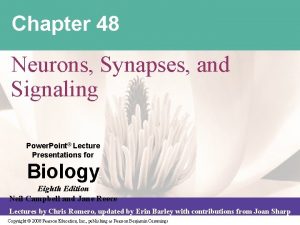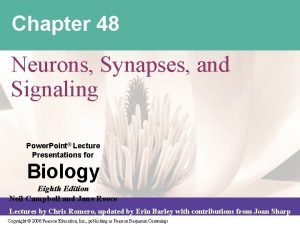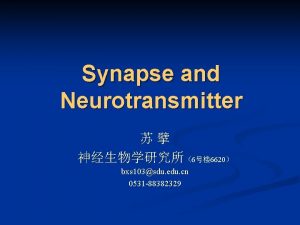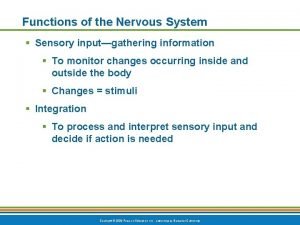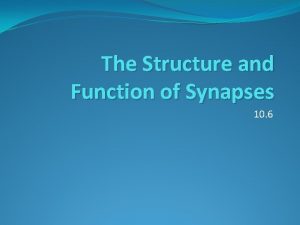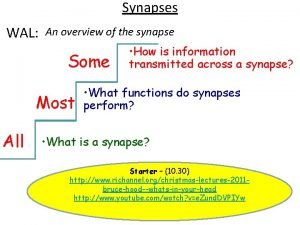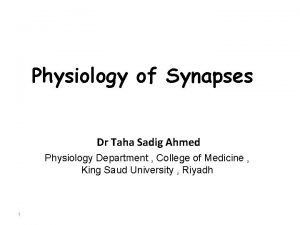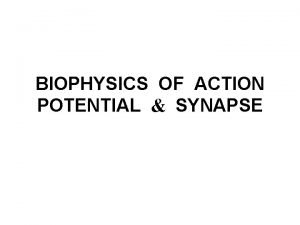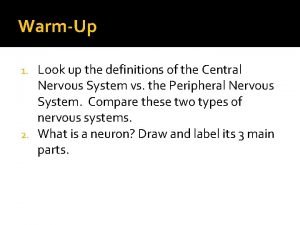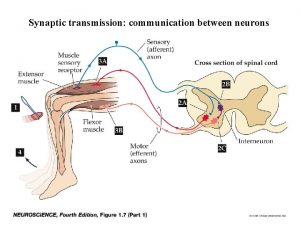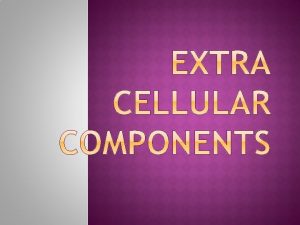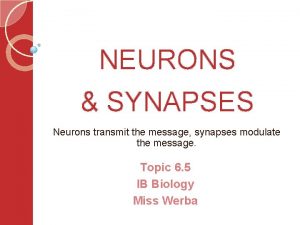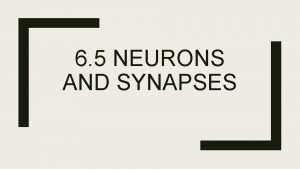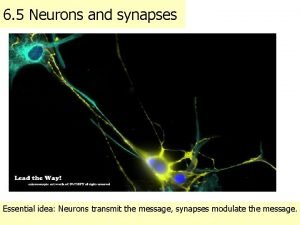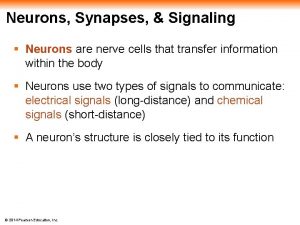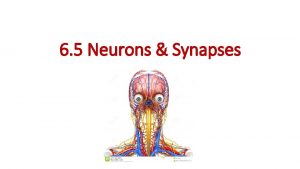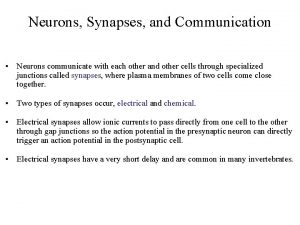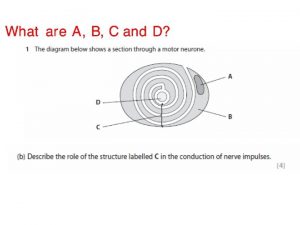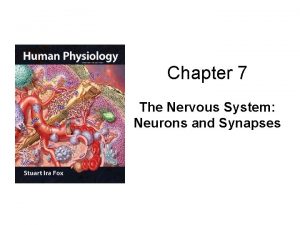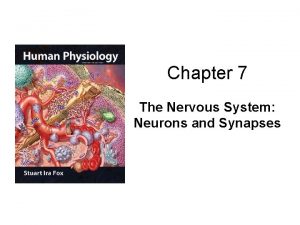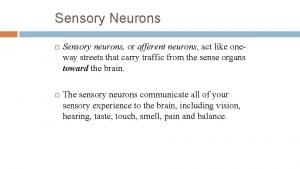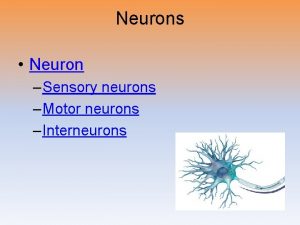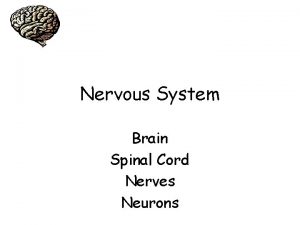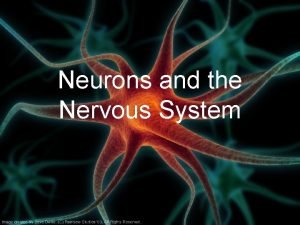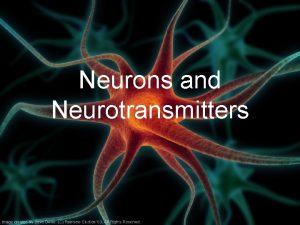6 5 NEURONS SYNAPSES The Nervous System Divided


















- Slides: 18

6. 5 NEURONS & SYNAPSES

The Nervous System • Divided into 2 parts • CNS: Central Nervous System • Consists of brain and spinal cord • Composed of neurons • PNS: Peripheral Nervous System • Consists of all the nerves that branch from the CNS and go to the rest of the body • Made up of sensory receptors and nerves • Afferent and efferent

Neurons

Neurons transmit electrical impulses • Send out rapid electrical impulses called action potentials • must be changed into a chemical message in order to cross the synapse (space between 2 neurons) • Carry message to a relay neuron inside the CNS • Relay neuron turns it into an electrical impulse • Then it travels to an effector cell (elicits a response)

Resting potential & Action Potential • Difference in electrical charge inside (cytoplasm) and outside (extracellular fluid) • Membrane potential • Controlled by sodium NA+ and potassium k+ • Neurons pump sodium and potassium ions across their membrane to generate a resting potential

Resting potential • The charge of a cell at “rest”. The neuron is not sending an action potential. Resting potential is maintained by the sodium-potassium pump. • At rest charge inside cells is more negative by -70 mv • Uses ATP to pump 3 Na+ out of cell and 2 K+ into cell • Some “leaky” channels (always working to maintain resting potential)


Action Potential • The changing charge in a cell due to the opening of sodium-gated ion channels (depolarization) followed by the opening of potassium-gated ion channels (repolarization) • Occur when a stimulus is detected • If cells depolarized to a charge around -50 mv and action potential is propagated (threshold potential)

Propagation of an action potential

Nerve Impulses • When action potential is propagated it moves down the axon to the terminal buttons • Axon is depolarized and then repolarized • Wave of traveling membrane charge changes • Myelinated axons speed up the transmission • Axon potential generated between nodes (between myelination, across Schwann cells) • Jumping of the impulse from one node to another is called saltatory conduction


Graph of an Action Potential

Synaptic Transmission • Synapse: space between two neurons or a neuron and a muscle cell • In order to carry and impulse across a synapse it needs to be changed from and electrical signal to a chemical signal • Chemical form is called a neurotransmitter • Stored in the terminal buttons of neurons • Arrival of action potential at terminal buttons triggers the opening of the calcium gated channels in the presynaptic membrane • Causes the release of neurotransmitters

Neurotransmitters • Excitatory: when they open sodium channels • Inhibitory: when they open potassium channels • Examples • Acetylcholine (cholinergic synapses) • Cholinergic synapses control muscle contractions • Dopamine • Serotonin • Epinephrine • norepinephrine

Useful applications for blocking cholinergic synapses • Pesticides: neuroactive insecticides bind to acetylcholine receptors causing the paralysis of insects. • Botox: toxin derived from the bacteria that causes botulism, stops muscle contractions by blocking the release of acetylcholine. The relaxed muscles reduce the appearance of wrinkles.

Removal of neurotransmitters • Must be removed from the synapse to stop the message being sent • Removed by enzymes • Removed by terminal buttons by reuptake (endocytosis)


• Receptor Interneuron Effector = Reflex • Does not involve the brain • Involuntary (ex. pain) • Adaptive behavior for survival
 Chapter 48 neurons synapses and signaling
Chapter 48 neurons synapses and signaling Chapter 48 neurons synapses and signaling
Chapter 48 neurons synapses and signaling Label the different types of neuronal pools in the figure.
Label the different types of neuronal pools in the figure. Nervous
Nervous Processes of neuron
Processes of neuron 2 types of synapses
2 types of synapses How is one way conduction at synapses ensured
How is one way conduction at synapses ensured Functions of synapses
Functions of synapses Synapses telecom
Synapses telecom Functions of a synapse
Functions of a synapse Renshaw cells
Renshaw cells Summation of postsynaptic potentials
Summation of postsynaptic potentials Bioflix activity: how synapses work -- synapse structure
Bioflix activity: how synapses work -- synapse structure Chemical synapses
Chemical synapses Electrical synapse vs chemical synapse
Electrical synapse vs chemical synapse Gap junctions vs plasmodesmata
Gap junctions vs plasmodesmata Nervous system and digestive system
Nervous system and digestive system Endocrine system and nervous system
Endocrine system and nervous system Amino acid-based hormones
Amino acid-based hormones
